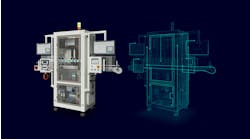I was walking around a custom machine builder's facility the other day and couldn't help noticing how run-down, dirty and unkept everything looked. The impression started from the parking lot and continued inside the building. Weeds, broken sidewalk and poorly maintained landscape all started a yellow caution light flashing in my head as this company was touting their innovative designs and manufacturing capabilities.
Do you guys ever notice that? I do, and I cannot help but think that the machine builder's customer does, also.
Although looks can be deceiving, I'm sure many potential customers wonder if the poor appearance bleeds over into poor machine design and workmanship.
Welcome to our facility
Maybe the machine builder's or integrator's management and owners think the money should only be spent on design and programming labor and no time or money should be spent making the lobby look first class. I suppose it is also possible that management doesn't notice how bad the office looks. A lobby with real chairs and a reception desk are a good start and there are many interior designers that can help with appearances, at little expense.
I walk into the conference room on dirty carpet, and I see what looks like a 30-year-old printer stand holding a 20-year-old VCR with a 10-year-old set of speakers and a nest of cables all covered in a very gray layer of dust. Fortunately, the crooked, bent and frayed blinds do help to move my visual focus away from the printer stand, as do the variety of non-matching chairs. The cherry on top is the half-full bowl of unwrapped breath mints with other debris sitting in the middle of the conference table.
You can do better than that.
A quick look around the shop can speak volumes on operation organization, procedures, craftsmanship and machine quality. If I am looking to buy a custom machine, it doesn't inspire my confidence to see a messy, unorganized shop with junk piled everywhere on table tops and on the floor.
Clear table tops containing only current work and well-organized and labeled storage areas go a long way in convincing me quality procedures exist. Of course, the floor shouldn't be embedded with dirt, grime and debris. I'm looking for clean, neat and organized, just like the machines should be, or I may take my business elsewhere.
Meet the expert
If you're the expert and discussing the innovative capabilities of the company, you probably already look the part or you would be working in a different capacity. However, the valuable designers and programmers working in the trenches should also promote company excellence by looking their best. What does your look say about your company and the importance of your position? If customers visit your facility, you need to look the part.
What does it take to look the best? Not much. It just means you have to look better than the guy in the baggy jeans and T-shirt or the guy in the aged, poor-fitting slacks and shirt with the worn-out, smelly shoes. Just look around; there are both good and poor examples on how to do the business casual engineer look—not the sloppy Google geek look.
If you step up your look a bit, people may even think you are the smartest person in the room, certainly more so than the slob in the corner anyway. Be sure to look the part, or the machines you are building may look a bit less innovative.
Documentation with pizzazz
A neat office and appropriate dress are important, but clean, well-done and complete documentation is required. It starts from the first email and proposal and continues until the final user manual is delivered during training. Something as simple as using all capital letters or thinking it is OK to use text-message-like punctuation in an email is sending the wrong message, literally.
Spend some time on the proposal appearance. It's an easy way to show a little something such as innovation and excitement for the design you are promoting. A massive paragraph promoting all the great things about the machine proposed may contain great technical content, but the appearance of just a PowerPoint top view of the machine with text pointers to critical features is something that can be discuss and used to base decisions on, as needed. And, although helpful, there is no need for your clothes to match the graphics.
The neat machine
The delivered machine look is probably the most important when discussing appearance in an industrial setting. If it looks good, it may appear to work better than it actually does. It certainly helps. The customer will also likely be more lenient if the machine doesn't start up as well as expected if it doesn't look like a ragged mess of equipment and wires.
On the outside of the machine, a poor paint job, dirt, scratches, messy wiring or missing and inconsistent wire labels inside the control enclosure are just a few of the indicators of what looks like a poorly done machine. An engineer may think the results of the design is enough to show worth, but, if that were true, fancy sports cars and trashcans with lids would not have been designed.
If you are working in the messy office or wearing inappropriate business clothes, you probably are thinking, “You sound like my mom.” Take a look at the leading machine builders and integrators. At the sales process, marketing, design, programming, manufacturing and documentation phase, they promote an innovative, well-organized, professional look. It's half the battle and surely one of the reasons they are leading their segments of industry.
What do your shop, documentation and machines look like?
Also read: Automation in Agriculture—how FireFly's turf harvesting machine ups productivity






